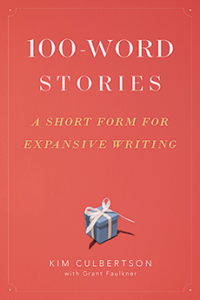Using 100-Word Stories for Expansive Writing
100-Word Stories: A Short Form for Expansive Writing
By Kim Culbertson and Grant Faulkner
(Heinemann, 2024 – Learn more)
Reviewed by Erin Corrigan-Smith

Well, not really. There is so much that students gain from reading a whole novel that simply cannot be expressed through mini texts, But does this hold true when we are teaching writing and writing skills? Is it essential that students complete an entire multi-page reading so they can then analyze it at length before they can craft a well-developed script of their own? Not necessarily!

The personalities of these writers shine through on the pages of 100-Word Stories: A Short Form for Expansive Writing and help to create and maintain a conversational tone where. As you read, it feels as though you are engaging with a colleague to discuss new ideas and to determine some new strategies for teaching writing for learners at all levels.
Easy access to referenced texts
The text comes with access to all the resources discussed in the book. If there is a specific story or chapter referenced, the authors worked with Heinemann to afford readers access to the versions used in the book. This allows the reader to immediately locate the resources and then use them with their students through platforms such as Google Classroom or other LMS platforms.
The chapters are organized by text, and the book is separated by “parts” that focus on specific skills. For instance, Part One reviews foundational elements, such as point of view (POV), which, thankfully, explores the concept of POV beyond first, second, or third person because the standard demands so much more, and teachers often neglect to consider the standard “behind the comma.”
Perhaps the best aspect of the book is the care given to the selected texts. Though the book is intended for use for all secondary students, the authors carefully considered their choices for reading and writing so that every level is represented. This is especially important in those settings where the students are not on level – and this resource can scaffold either up or down to meet the needs of students in grades 5-12.
One downside of the text has maybe more to do with the organization of the text than anything else – none of the chapters are identified by page number in the Table of Contents, so navigating the book is a bit cumbersome. The “parts” of the book are offset by colored pages, making it easy to find the beginning of the next (or previous) part, but finding the individual sample is still a minor irritation.
Tying writing to reading
A key strength of the chapters is the inclusion of ways to tie the writing to reading so students can practice a multitude of skills. At the end of each chapter there is a suggestion box of ways to transfer the skill from the writing – such as character and character development from the sample story – and use that skill with a classroom text.
Whenever possible, it is a great idea to tie similar concepts together so students can see the value they have when they are intertwined. As language arts is the practice of teaching skills and not, necessarily, content, it is important to tie the skills together in as many ways as possible, so students continue to use the skills in ELA and beyond.
Overall, this short text is a wonderful resource for teaching literacy skills with micro texts and for helping students develop both writing and reading mastery.
Erin Corrigan-Smith is a secondary ELA teacher in a northern suburb of Atlanta. She has both a B.A. and M.A. in English, and her focus of study is children’s literature. She has been working towards an Ed.D. in Reading and Literacy, and she is now an official doctoral candidate in her program. In her downtime, Erin enjoys going to her family’s cabin in the North Georgia mountains with her husband and dog, reading, working on her never-ending piles of homework, and relaxing.




























